Did I ever mention that I like GP30’s. I'd like to see the KCS GP30 produced! The do not believe the C&O GP30 has ever been produced in O Scale. Please post a picture of your favorite GP30 model.
Regards,
Swafford
|




|
Replies sorted oldest to newest
When will a manufacturer offer the N&W (or Southern) high short hood GP30? Those are the best looking GP30s ever built, in my opinion!
Had no idea, Frank. ![]()
I like them, too, but only own one -- EMD Demonstrator. Missed out on the others or they were in that fictional road I don't like to talk about. Would like to see MTH do the pinstripe/bookend ATSF's and CNW in Premier with Proto-3.
I will want to pick up one the WBB GP30's when they're released. Probably the GN.
Alan
What GP30's should look like!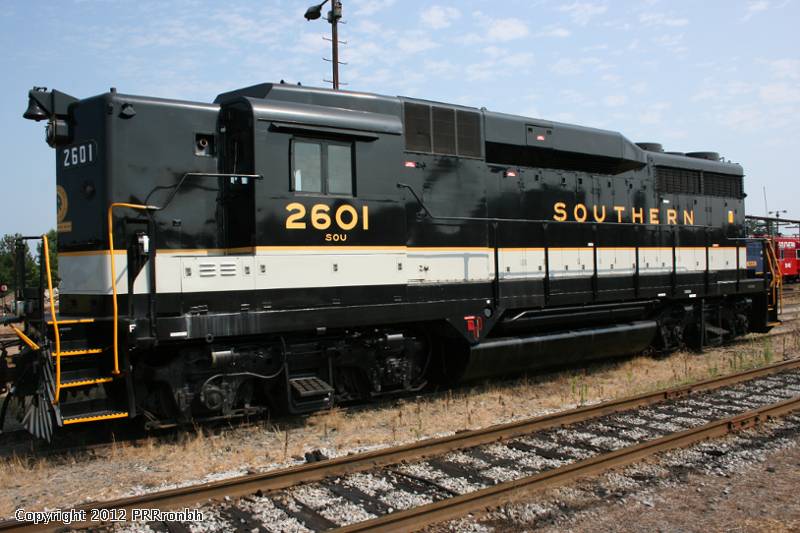
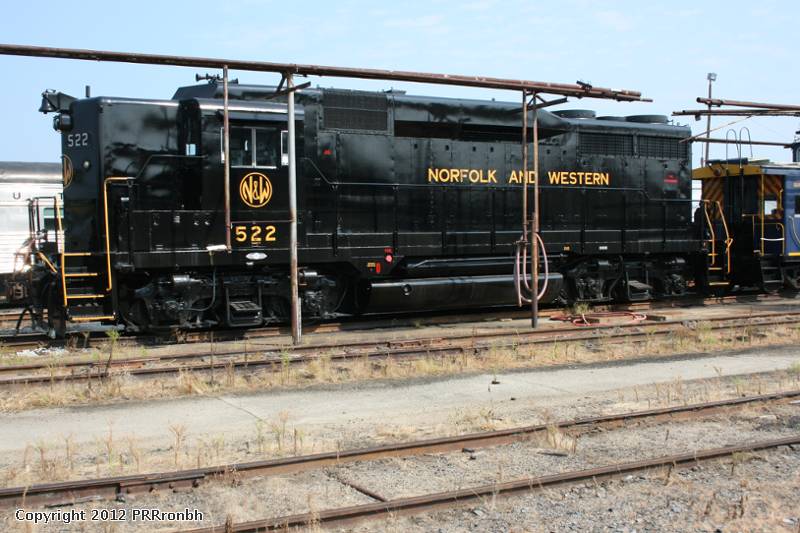
Here is MTH Premier Reading 5513 (the first production GP30) in a meet with Reading T-1 2100 painted and detailed as Reading 2124 by Reading Steam Guru. The 60' Madison cars are Williams in a two-tone green Reading Company scheme. The GP30 is pulling a freight headed by a Weaver Reading hopper with speed lettering.
FYI for those in the Baltimore area, the B&O Museum's short excursion train is being powered by a former B&O GP30 in "Sunburst" paint for the next (likely) few weeks. Rare to see that engine in public view. Rarely operates and rarely pulls public trains.
Earlier this summer, I had the opportunity to operate Western Maryland Scenic GP30 502 for about 2-3 miles. Neat experience.
What GP30's should look like!

Now THAT's what I'm talking about!!!
I have a custom made trio of N&W GP30s, #524, #525, & #527, in HO scale in my display case. Sure would like to get the exact same three units in O-Scale.
Something different, BN GP30 modified to be a GP39E. What did the E stand for? This would be a net model!
Regards.
Swafford
The "E" meant that the complete rebuild was done by EMD. The other two rebuilders of those original GP30s was: "V" for VMV, and "M" Morrison-Knutson. All those old GP30s and GP35s received rebuilt 645 prime movers, an AR10 main generator/alternator, Dash-2 electrical controls, AAR control stand, and a bunch of other stuff I can't remember.
Hot Water: I remember hearing that the GP30 was not a totally successful engine as built by EMD. I'm not sure just what it's problems really were but I know that there were far fewer built than the GP-38 series.
Am I right on that or am I confusing that with another engine?
Paul Fischer
The GP30, with its 567D3 turbocharged engine, really didn't have that many problems. The electrical system was, however much more problematic. Plus the GP35 came out pretty quickly.
Hot Water, when Mike Wolf was here for the NS Heritage event several of us expressed the desire for a high hood GP30. When I told him that there are probably two ways to do the Southern (with and with out the front seal) and five or six ways to do the N&W (lettering, logo, and paint color) plus the NS version he raised an eyebrow. He then went out to the two I pictured here to take pictures. So we can hope.
And since we have an operating GP30 here an authentic sound file could be recorded.

Love those Hi-hood GP 30's and I am a steam guy! ![]()
Visit my new website Bo's Trains at http://www.bostrains.com
My repainted Lionel GP30. Of course after I did this, WBB announces they are going to do C&O GP30's.
I like it. What did it start out as?
Its the Lionel GP30 non powered unit. I have a powered Legacy unit as well, just haven't worked on it yet. Needed to practice with the dummy unit first.
The truck sideframes were modified by removing the outter brakeshoes, fixed pilots which was a major modification, removed footboards from pilot and scratch built the flat pilots you see now (another major project), new air hoses & MU hoses, speed recorder cable, cab vents, removed the sun shades and mounted in the down positon, removed crew figures, roof top AC unit, scratch built antenna mount, painted the anti glare panel on the nose and tops of walkways, added fuel sight glass to one side of tank that Lionel forgot, and then a light weathering to tone down the bright yellow.
GP30 with a high hood difines UGLY!
First TMCC loco I ever bought was the B&O GP-30 in the sunburst livery. Looks like the one up at the museum in Baltimore.
Give me some of that high nose GP30 action! Some of them even made it into NS livery:
http://www.rrpicturearchives.n...Picture.aspx?id=9104
Bob
Why did GM put that roof casting on the 30's? It is unlike anything else they made.
And UP did have some GP30B's. I have read the B's had steam generators. Were they ever used on passenger trains?
I'm not sure why GP30s have a reputation for being ugly. IMHO they were the only hood unit that, to my eyes, had given ANY consideration to style. If the GP30 were a steamer, we'd be calling it "Semi-streamlined."
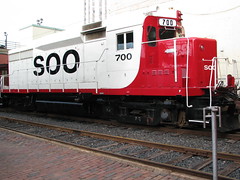
Soo Line GP30 #700
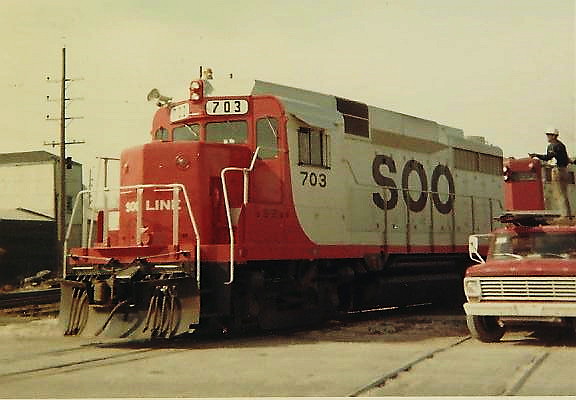
Soo Line GP30 #703
Andrew
From a technological standpoint, the GP30 was EMD's first unit with a pressurized carbody. They also made a jump in the model numbers just for the heck of it. I remember a GE guy reminiscing, "we were really worried when EMD came out with the GP30 ... we thought they had a 3000 HP unit!" This was after the SD24 that had 2400 HP.
I've wondered if the unique carbody styling had anything to do with accomodating the new Dynavanes air filtering setup which did inertial filtering of air for the equipment blower and engine air intake. I didn't get to work on locos that old and never inspected one that close.
I remember seeing A-B-A sets of GP30's working UP's Park City branch in Utah circa 1978. They looked good in that arrangement.
Along the Columbia River in 1968, this consist has at least three GP30's. I took this shot with my first Brownie camera, my second roll of 8-exposure film, and always thought this photo had an odd model-railroad look to it with a painted backdrop. Little did I know that I would be working for UP 10 years later, by which time the GP30's were mostly shuffled off into secondary duties.
On the subject of the GP30, I've seen the new WBB unit. It's refreshing to see a combination of a correctly proportioned , well detailed shell mounted atop a smooth running mechanism without the electronics required for command control operation for those of us who prefer to run conventionally. I hope the GP30 is an indicator of more like this coming our way.
Bob
On the subject of the GP30, I've seen the new WBB unit. It's refreshing to see a combination of a correctly proportioned , well detailed shell mounted atop a smooth running mechanism without the electronics required for command control operation for those of us who prefer to run conventionally. I hope the GP30 is an indicator of more like this coming our way.
Bob
Here here!!! I have one GP-30. A dead MTH Premier unit I got cheap. Put a WBB DCU in it and I am a happy owner!!! MTH Premier looks with simple brain! I am sure I'd be happy with a WBB unit when they do a road I like but until then my D&RGW Frankenstein unit will do.
I hate to admit it but that ugly thing is starting to grow on me.
Maybe if Williams paints one like this I will buy one.
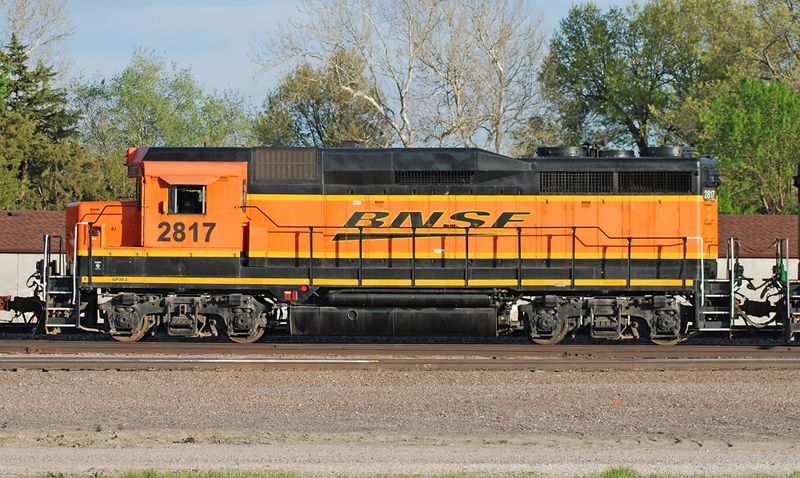
Good Day,
Anyone have a close up picture of a Union Pacific GP30 A-B-A set?
Regards,
Swafford
I like GP30's too. I think they're very unique looking loco's and tend to stand out when mixed with other geeps or other larger loco's. I consider them to be "old school classics".
I'm currently building a few of them in 2rail. I'm experimenting with mating a Lionel SP GP30 to an Atlas GP35 chassis, although the cab is a phase I and not the phase II found on SP prototypes. I like WBB GP30 for the fact that it is a phase II cab that the SP used on their prototypes. and I think it looks good with the extended cab. I'll start purchasing a few of the WBB 30's just for the phase II cab. I saw them upclose at a recent show, and although they aren't as detailed as the Lionel version, they look pretty nice, and since I plan on just using the shell for my conversions, the price is very attractive. MTH and Lionel only manufactured the phase I cabs on their GP30's. Here are a few pics of my experiment.
What GP30's should look like!

love that N&W
Although I love the look of the GP30, the high hood ruined the styling, IMHO. Oddly enough, I generally always favored high hoods, but in this case I'll make an exception![]() !
!
Stack
Good Day,
Anyone purchase GP30's from the latest MTH production run? That CB&Q looks great!
Regards,
Swafford
The best I see is that there were may be six scheme variations of the Norfolk & Western high nose GP30s. Two variations for the Southern, in fact three or may be four if you add the RC equipped. Then a NS version. Plus the possible short lines variations. So it seems like there could a return on the dollar to produce these.
Seem to remember a Trains article stating that the body for the GP30 was designed by the GM styling department. For cost saving reasons the replacement GP35 went back to the more typical geep styling. The GP30 was many railfan's favorite geep. MY Lionel CSX GP30 gets run often.
Did I ever mention that I like GP30’s.
Regards,
Swafford
NO.
Good Day,
I'd like a trio of these GP30's!
Regards,
Swafford
Well you may want to start looking! ![]()
Speaking of high hood GP30's, Western Pacific had an order in for 10 of them in silver and orange with high hood noses and their signature garbage can headlights. Too bad they were so far down on the list EMD told them if they went with GP35's they'd be on the top of the list. The rest is history, WP never continued their high hood purchases but I can see an NW unit getting kitbashed into a what if WP unit. ![]()
Greg
Swafford,
Check out this link, they're S scale and not quite notch 8 but they sound good together. http://www.youtube.com/watch?v=QfX-5In1EG0
Good Day Superpower
WOW, Those S Scale GP30's in the video look great.....sound great! Thanks for sharing the video.
Regards,
Swafford
I have to agree that the highhood GP30s are nice looking, especially Southern 2601. A few years ago, I got to go up to Spencer with a friend and rode in the cab. The blue light (I think it was the blue one) kept illuminating and a bell would ring. The engine would keep shutting down. A mechanic went to look at 2601 and after that, the crew went to fetch the navy switcher and let us ride in it! Has either Lionel or MTH made a Southern GP30 numbered 2601?
What GP30's should look like!

Have never seen 522, how often does it come down to Spencer, NC?
How about some ARR:
GP30 #2000 was acquired new in 1963. It was the Alaska Railroad's first 2,250 H.P. diesel electric locomotive. It arrived at Whittier on April 20, 1963 amid a blinding snowstorm. It was rebuilt as GP30u 2504 in 1974.The photo above was taken when she was first delivered. It is along side of the Anchorage shops on the fuel rack.
EMD GP30 no. 2000 (builder number 28171) was acquired news in 1963. It was
rebuilt in 1974 as a GP30u no. 2504 and finally retired in 2001. Number 2000 is shown in Fairbanks on 5/12/73. Photo courtesy of the Dean Motis Collection Photographer unknown
Cold and Ugly, but it was new.

Soo Line GP30 #700

Soo Line GP30 #703
Andrew
Good Day Everyone,
Have you added a GP30 to your model railroad yet?
Regards,
Swafford
"M" Morrison-Knutson.
Actually it's spelt "Morrison-Knudsen"
I like GP30's too. I think they're very unique looking loco's and tend to stand out when mixed with other geeps or other larger loco's. I consider them to be "old school classics".
I'm currently building a few of them in 2rail. I'm experimenting with mating a Lionel SP GP30 to an Atlas GP35 chassis, although the cab is a phase I and not the phase II found on SP prototypes. I like WBB GP30 for the fact that it is a phase II cab that the SP used on their prototypes. and I think it looks good with the extended cab. I'll start purchasing a few of the WBB 30's just for the phase II cab. I saw them upclose at a recent show, and although they aren't as detailed as the Lionel version, they look pretty nice, and since I plan on just using the shell for my conversions, the price is very attractive. MTH and Lionel only manufactured the phase I cabs on their GP30's. Here are a few pics of my experiment.
Looks good Superpower,
Are you also going to also add the SP lighting package?
Got a shot of this BNSF GP-39 yesterday in Dalhart, TX (in the panhandle) on the way back from Denver. I think this is one of the GP-30s that was rebuilt by BN; they put a GP-38 engine in the GP-30 body. Nice seeing a "GP-30" in active service, even if it's re-engined. Additionally nice seeing an engine with a Santa Fe paint job hooked up with it.
Good Day Everyone,
Have you added a GP30 to your model railroad yet?
Regards,
Swafford
The only diesel on my roster.

What are the spotting features of a phase 1 vs. phase 2 cab?
On the phase I the cab side windows are centered on the cab, on the phase II the cab is longer so the windows are closer to the front of the cab.
Good Day Everyone,
Have you added a GP30 to your model railroad yet?
Regards,
Swafford
Will add more to the stable if offered in the next MTH catalog. Did get one of my ATSF GP35's today. Will try to get it out onto the layout this weekend.
http://www.rrpicturearchives.n...icture.aspx?id=89553
The Chicago & Eastern Illinois owned three GP30s. When they merged with the Missouri Pacific, the GP30s briefly had a red C&EI buzzsaw on the cab and were renumbered into the Mopac numbers. After a brief stay, the 3 GP30s were given to the Louisville & Nashville as part of the agreement to split the C&EI up.
Dan
looks like CSX has made road slugs out of them
Those CSX guys never even blew the horn when backing up over the crossing?
Not a GP-30 but this MTH Ohio Central GP-35 from Jason's Trains showed up at the door last week. The MTH Ohio Central GP-38 now has a lash-up partner.
Good Day Bill,
The Ohio Central Geep's looking good! I like that color scheme!
Regards,
Frank
Wow Frank. What is that one? I'll have to look for more details about it. I have a G scale GP30 that I'd like to modernize. I thought they were all used as slugs by now?
I like the look of that Seaboard unit.

Something different, BN GP30 modified to be a GP39E. What did the E stand for? This would be a net model!
Regards.
Swafford
The "E" meant that the complete rebuild was done by EMD. The other two rebuilders of those original GP30s was: "V" for VMV, and "M" Morrison-Knutson. All those old GP30s and GP35s received rebuilt 645 prime movers, an AR10 main generator/alternator, Dash-2 electrical controls, AAR control stand, and a bunch of other stuff I can't remember.
Good Day,
I wondering what road names Lionel will present next time?
Regards,
Swafford
I had to add a picture of the completed engine to the thread. My earlier post still had painters tape in the windows and no weathering.
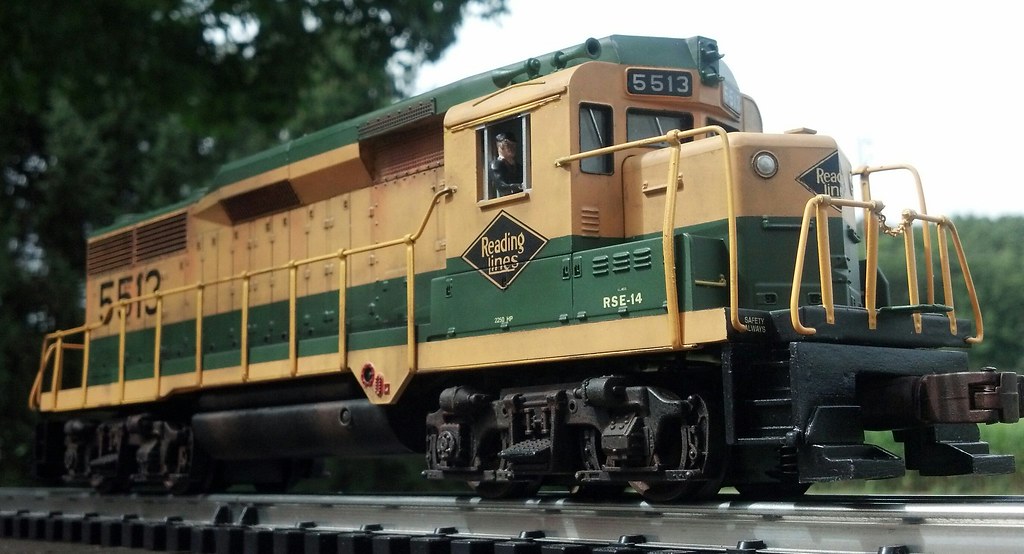
Still some work to do on the pilot and some detail parts to add, but my RDG GP30 is 95% complete. (Well, until I upgrade to PS2 and add marker lights.)
Fans of the GP30 should take a look at the new Lionel catalog. There are high nose N&W and Southern units in it.
Bob
Mike R. and the other four or five Lionel reps that visited the local toy train shop in Spencer (Concord only a few miles away) several times within the last year LISTENED!
I have been emailing a VP at MTH for at least 4 or 5-years about a High Nose GP30. When Mike W. was here 2+-years ago for NS-Heritage Event discussed with him. He claimed he was going to take picture of “our” active Southern 2601. At that time we also were hosting an active N&W 522. But obviously NO action. On the other hand Mike R. and company LISTENED in less than a year.
Ron
The Reading & Northern bought some of the old Santa Fe GP-30's and might have painted up for Reading & Northern RR. Reading & Northern the regional railroad in eastern PA.
Lee Fritz
The Reading & Northern bought some of the old Santa Fe GP-30's and might have painted up for Reading & Northern RR. Reading & Northern the regional railroad in eastern PA.
Lee Fritz

Nice photo of the GP-30. How about a side view?
Lee Fritz
Frank, check out the new Lionel catalog.
Larry
I don't know that I like the GP30 enough to pay the inflated prices in the new catalog, even with discounts.
I like the GP30. Thankfully, they did not have any of my railroads included this time.
There is the MTH catalog coming in 5 or 6 weeks.
Andrew
I don't know that I like the GP30 enough to pay the inflated prices in the new catalog, even with discounts.
Boy, tell me about it! I model the steam era of early to mid 1950s, but I began my career with EMD delivering the GP30s to the N&W Rwy, during late June 1962. Yes, I REALLY want one of those hi-nose N&W models, ESPECIALLY if they offer road numbers 524, 525, or 527, as I made my first "road trip" on those 3 units, up to Hagerstown, MD.
But, I do NOT plan on paying over $500 for just one darned model!!!! What in the world is going on with Lionel and their pricing?
Lee Fritz


my last train movie features a lot of gp30 action...
and I just so happen to have an Overland SOU HH ph 2....thinking of doing it N&W
whats the difference in ph1 and ph2
I agree with laidoffsick. I was hoping for some Santa Fe's in the original paint. I would also like to get some Cotton Belt, Great Northern and KCS. So my wallet is safe as well. I might break down on a demo model. But first if I am going to spend $470, I want somebody at Lionel Guarantee that the back steps align. Remember the last fiasco. That kept me from buying the SP version until one came up on e__y for $250 brand new. For that price I forgave the problem.
Here's a little something for the NYC fans...
http://m.youtube.com/watch?v=_xo2EGP-DXg
Can't post pics from my phone, but will soon!
Thanks,
-Mario
I took notice of the UP version, but don't like the paint scheme nearly as well as the previous set (late TMCC R/S 5 version) that I have. The earlier set has the larger "Union Pacific" lettering and engine number on the side, red with black outline, among other things, which I much prefer. And there is a matching dummy unit.
Maybe I missed it, but I haven't seen anyone comment that there are no dummy engines available with this new group of GP30s.
Maybe I missed it, but I haven't seen anyone comment that there are no dummy engines available with this new group of GP35s.
Yes, but I thought we were all discussing GP30 units.
Maybe I missed it, but I haven't seen anyone comment that there are no dummy engines available with this new group of GP35s.
Yes, but I thought we were all discussing GP30 units.
No dummies with the GP30s, either! (made the correction![]() )
)
Any new pictures of your EMD GP30's?
Have a great day!
Regards,
Swafford
Three UP GP30's on a grain train in 1983. Wasn't too long after that UP would start retiring them. Did I miss pictures of the Bachmann model? Any comments on their fidelity to scale?
Greg
There is just something about a GP30 and the remarkable thing is that carbody is still in mainline service today.
Since this thread began back in 2012, I've since acquired a couple of GP30's from a forum member. I immediately removed a four-letter word from the cabs and corrected the cab numbers. I plan to fix the pilots, relocate the horns and set them up as GP30U's.
Gp30's are starting to grow on me...i can see me owning a pair working an industrial siding.
PRRronbh posted:What GP30's should look like!
Darn right!
I never met a GP30 I didn't like, even a CSX slug................
Here in the Pacific Northwest, you run into a lot of older diesels. I still see GP30s on the high iron every now and then.
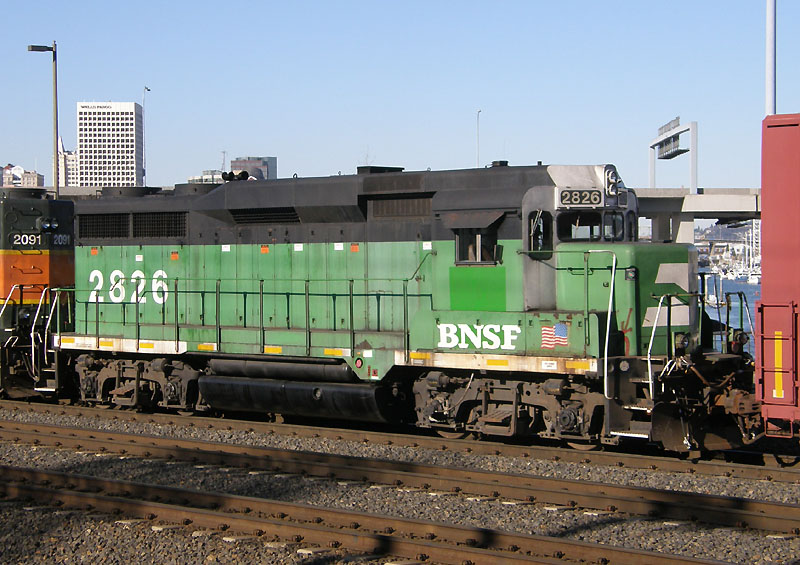
p51 posted:PRRronbh posted:What GP30's should look like!
Darn right!
Seeing this reminded me that when Lionel released these in O-Gauge.
I added them to the roster.
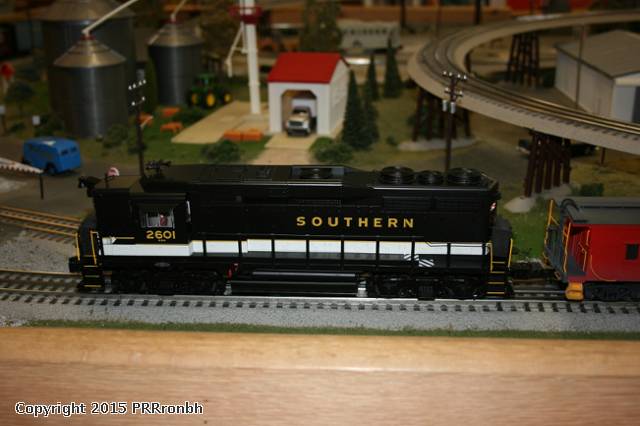
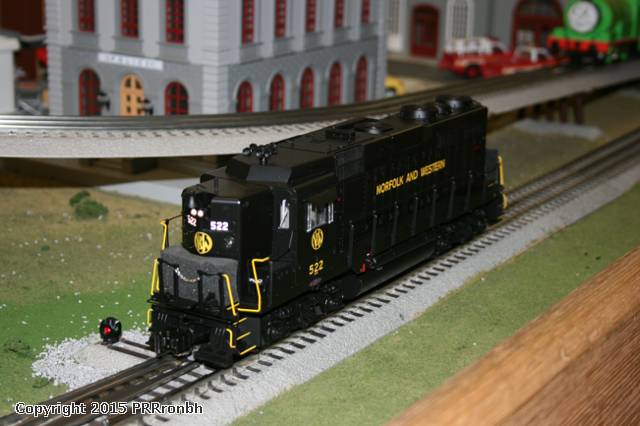
Ron
p51 posted:PRRronbh posted:What GP30's should look like!
Darn right!
Nonsense... This is how GP30's were meant to look.
Rusty
I remember that in the early/mid 1960's when the B&O was just about finished daylighting many tunnels on the routes to St. Louis and Chicago, an order was delivered from EMD for 77 GP-30s. Wow they really looked neat with the sunburst logo on the nose. At the same time 3 pairs of hotshot piggyback freights were established from Jersey City, NJ via CNJ-RDG-B&O...Potomac, St. Louisian and the Chicagoan westbound from Jersey City and the Hudson, New Yorker Trailer Jet and the Manhattan Trailer Jet. These trains were the fastest freights operating at that time on the Jersey Central.
(All photos from Fallen Flags website)
Enjoy.
Walter M. Matuch
The National Capital Trackers have had a Layout in the B&O Museum for a couple of decades at Christmas. This year, I was running a pair of B&O GP-30s and went out for a cab ride (perk of being a Tracker) in the museum train. I was very surprised that it was the same loco and same paint scheme as I was running inside.
What a great day!
Not a fan of the yellow frame stripe on the as delivered Reading and Lionel GP-30
Apparently the Reading didn’t care for it either as they repainted the lower sides of their GP-30’s green very early in their careers
Found a green paint that was pretty much a perfect match to Lionels
Very happy with the way this came out
Thanks
dorfj2 posted:Not a fan of the yellow frame stripe on the as delivered Reading and Lionel GP-30
Apparently the Reading didn’t care for it either as they repainted the lower sides of their GP-30’s green very early in their careers
Found a green paint that was pretty much a perfect match to Lionels
Very happy with the way this came out
Thanks
Looks great! Can’t tell it’s not factory painted!
How many others worked on GP30's and had to cut out a traction motor by using the little plastic flag on a power contractor? I always made sure to remove anything metallic before sticking my hand down there.
GP30 is a favorite of mine also. I have a Conrail Legacy pair, a pair of Santa Fe MTH, and an MTH Chessie System B&O.
Did any of those high hood NW & SOU units make to the NS era?
VistaDomeScott posted:GP30 is a favorite of mine also. I have a Conrail Legacy pair, a pair of Santa Fe MTH, and an MTH Chessie System B&O.
Did any of those high hood NW & SOU units make to the NS era?
Yes the high hood GP30s did survive in to the NS era.
Neal Jeter
@Swafford posted:
And so, after all these years, this has finally come to pass.
Many thanks to Steve Nelson (Mr. Muffin) and Lionel for the special run!
I had not thought about this for years, but this topic prompted my aging brain to conjure up some memories. GP30's were the first Santa Fe units from EMD that were built with centralized air filtration and pressurized carbody. The idea was that slight pressurization would keep dust and dirt outside, and, normally, it had a positive effect.
However, if the filters became clogged, the fan still took in air from wherever it could obtain it, and the cab compartment appeared to be ideal for this. In winter, when a GP30's filters needed to be changed or cleaned, the cab heaters could hardly make any difference. I have seen my breath in the cab on more than one occasion. Imaging ascending Cajon Pass for over an hour, in Run-8, with the centralized air filtration fan sucking winter air into the locomotive via the cab. Brrrr.
No photos but I have a pair of O scale NJ Custom Brass GP30s with Central Locomotive Works drives painted in my Eastern Maryland colors.
I also have a "what-if" HO scale SD30 shell created out of a pair of Bachmann GP30 shells and designed to fit on an Atlas SD35 chassis; someday I just might get around to completing it:
Not to mention a "Super 30", note the "Hi-Ad" trucks:
At some point in time, the flared radiator section from an SD45 will be added to the Super 30 although I will use a different shell, I like the Sunburst scheme too much to ruin the B&O shell.
GP30s do look pretty cool with the hump above the roof. I actually got to drive the UP #844 GP30 at the Nevada Southern Railway Museum in Boulder City, Nevada about 11 years ago for my 18th birthday. Wow! What an awesome experience, which I would absolutely recommend to any train fans. I just went to the museum recently to just ride the train. Lionel made the GP30 #844 a while back with TMCC, but I am really hoping they will re-release the engine again with Legacy control. I will totally buy it and some matching freight cars (preferably in a set). I may get one of the new BNSF Patched GP30s from Lionel, but I really want the #844 GP30.
@Number 90 posted:I had not thought about this for years, but this topic prompted my aging brain to conjure up some memories. GP30's were the first Santa Fe units from EMD that were built with centralized air filtration and pressurized carbody. The idea was that slight pressurization would keep dust and dirt outside, and, normally, it had a positive effect.
However, if the filters became clogged, the fan still took in air from wherever it could obtain it, and the cab compartment appeared to be ideal for this. In winter, when a GP30's filters needed to be changed or cleaned, the cab heaters could hardly make any difference. I have seen my breath in the cab on more than one occasion. Imaging ascending Cajon Pass for over an hour, in Run-8, with the centralized air filtration fan sucking winter air into the locomotive via the cab. Brrrr.
A few GP30 memories.
I can recall numerous trips across the flatlands of Northern Ohio and Indiana in the late 70's and early 80's, rolling along through the countryside with a GP30 in the lead at 50-60 MPH, and operating through some of Mother Nature's harshest, most brutal winter conditions she could muster up in the Great Lakes Region. A common practice among crew members, was to soak the Scott C-Fold paper towels that the company supplied in water, then place them around the window and door seals of the cab. The frigid winter air being pulled into the cab would quickly freeze the wet paper towels in place, forming a much tighter weather seal, thereby keeping the cab a little more comfortable.
When I hired out in 1977, Chessie's (B&O/C&O) were 15 years old. The old heads still referred to them as "Cadillacs". Opinions differed as to how they acquired that nickname. Some said it was due to their unique styling reminiscent of GM automobiles, others attributed it to the somewhat larger, more spacious cab the GP30 had when compared with previous GP series road switchers. As with many things on the railroad, it was probably a combination of both.
I also recall that if you had one anywhere in your locomotive consist, you had to be mindful of it, especially when starting your train. More often that not, if any locomotive was going to experience a wheel slip, it would be the GP30(s). As they aged, their many stages of transition became more and more troublesome. By the early to mid 80's, many were rebuilt into GP30m's while others became road slugs and served many more years. In spite of these traits, overall they were a pretty good locomotive when functioning properly.
C.J.
Somehow I missed riding in the cab of a GP30, though CNW had 'em and I saw them out on the road, periodically. However, all but the newest SD40s and SD45s had the same leaky door seal issues enumerated above. Once you had a pretty good seal, made with frozen paper towels, the door had to be opened for work to be done and the process of sealing began again. It became a futile effort but it gave the Fireman something to do.
@Number 90 posted:How many others worked on GP30's and had to cut out a traction motor by using the little plastic flag on a power contractor? I always made sure to remove anything metallic before sticking my hand down there.
In a similar situation, we had an ex-CB&Q GP30 as a second unit that would not actuate the sander from the headend. I had to go back and work it manually up a long grade on a rainy day in Oklahoma.
These locomotives remind me of Toyota pickups which will eventually wear down to a point where every feature becomes non-functional, yet they will still start and run all day long.
I love GP30's, I love Chessie, and most of all I love early CSX. So the new Lionel GP30's were a no brainer to me. I renumbered mine to 4200 and added a few extra details such as a side mounted bell and air vent on the cab as well as a few paint mods to model a "GP30M", or a unit that underwent a Chessie rebuild program in the early 80's. Then a moderate weathering.
What's up with the step and pilot mis alignment on the latest Legacy release?
@ES44AC posted:I love GP30's, I love Chessie, and most of all I love early CSX. So the new Lionel GP30's were a no brainer to me. I renumbered mine to 4200 and added a few extra details such as a side mounted bell and air vent on the cab as well as a few paint mods to model a "GP30M", or a unit that underwent a Chessie rebuild program in the early 80's. Then a moderate weathering.
I did the same; adding a side mounted bell...

Thanks!
- Mario
They are still being produced in limited numbers.
Access to this requires an OGR Forum Supporting Membership
